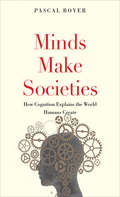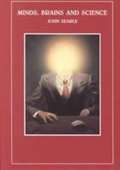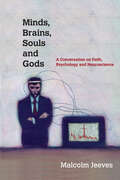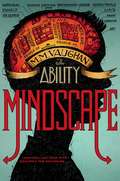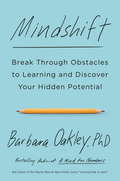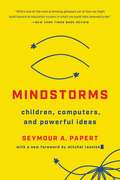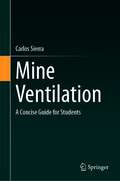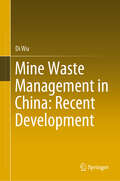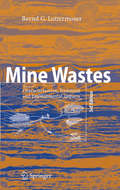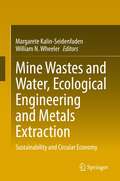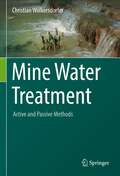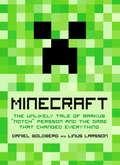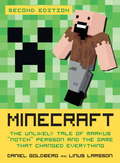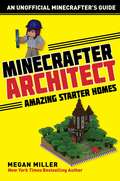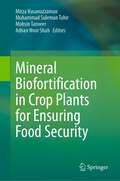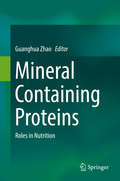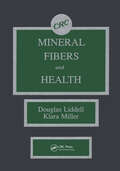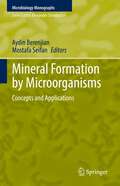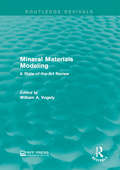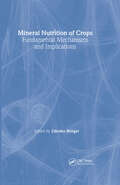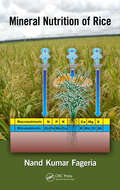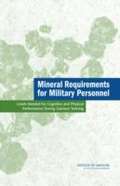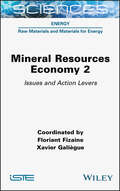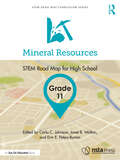- Table View
- List View
Minds Make Societies: How Cognition Explains the World Humans Create
by Pascal BoyerA scientist integrates evolutionary biology, genetics, psychology, economics, and more to explore the development and workings of human societies. &“There is no good reason why human societies should not be described and explained with the same precision and success as the rest of nature.&” Thus argues evolutionary psychologist Pascal Boyer in this uniquely innovative book. Integrating recent insights from evolutionary biology, genetics, psychology, economics, and other fields, Boyer offers precise models of why humans engage in social behaviors such as forming families, tribes, and nations, or creating gender roles. In fascinating, thought-provoking passages, he explores questions such as: Why is there conflict between groups? Why do people believe low-value information such as rumors? Why are there religions? What is social justice? What explains morality? Boyer provides a new picture of cultural transmission that draws on the pragmatics of human communication, the constructive nature of memory in human brains, and human motivation for group formation and cooperation.&“Cool and captivating…It will change forever your understanding of society and culture.&”—Dan Sperber, co-author of The Enigma of Reason&“It is highly recommended…to researchers firmly settled within one of the many single disciplines in question. Not only will they encounter a wealth of information from the humanities, the social sciences and the natural sciences, but the book will also serve as an invitation to look beyond the horizons of their own fields.&”—Eveline Seghers, Evolutionary Studies in Imaginative Culture
Minds, Brains And Science
by John SearleMinds, Brains and Science takes up just the problems that perplex people, and it does what good philosophy always does: it dispels the illusion caused by the specious collision of truths. How do we reconcile common sense and science? John Searle argues vigorously that the truths of common sense and the truths of science are both right and that the only question is how to fit them together. <p><p> Searle explains how we can reconcile an intuitive view of ourselves as conscious, free, rational agents with a universe that science tells us consists of mindless physical particles. He briskly and lucidly sets out his arguments against the familiar positions in the philosophy of mind, and details the consequences of his ideas for the mind-body problem, artificial intelligence, cognitive science, questions of action and free will, and the philosophy of the social sciences.
Minds, Brains, Souls and Gods: A Conversation on Faith, Psychology and Neuroscience
by Malcolm JeevesMinds, Brains, Souls and Gods,Do I have a soul?How free am I?What makes me uniquely human?Does my brain have a "God spot"?In this hypothetical correspondence with a student, Jeeves argues that we must avoid false choices in the relation between Scripture and science. Christians need not choose between a "God of the gaps" that competes with science, a "neurotheology" that bases our understanding of God on the latest scientific theory, or a scientific reductionism that claims to have explained God away as a mere function of the brain. Students encountering the brave new world of neuroscience need not view such research as a threat to the faith. With the wisdom of a seasoned scholar, Jeeves guides us down the road less-traveled—the way of integration.
Mindscape
by Iacopo Bruno M. M. VaughanTelekinetic preteens use their powers for good--and evil--in this mind-bending sequel to The Ability, which Publishers Weekly called a "fast-paced, superhero-tinged spy novel."Everywhere that Christopher Lane turns, he sees the face of the boy he killed. There is no escape from the guilt, not even on his return to Myers Holt--the secret London academy where he and five others are being trained to use their mental powers, their Ability. But now that the threat of Dulcia Genever has been dealt with, his friends are too busy working for the police, entering the minds of some of the country's most dangerous criminals, to sympathize. Chris's teachers are already concerned enough about him, especially when Chris starts to wonder if the boy may not be a figment of his imagination after all. Meanwhile, alone in Darkwhisper Manor, Ernest Genever is enjoying watching Chris's torment. Yes, he will keep his promise--Christopher Lane will die--but not until he has watched Chris lose his mind waiting for Ernest to appear. For, if nothing else, Dulcia Genever did teach her son one valuable lesson: Revenge is a dish best served cold.
Mindshift: Break Through Obstacles to Learning and Discover Your Hidden Potential
by Barbara OakleyMindshift reveals how we can overcome stereotypes and preconceived ideas about what is possible for us to learn and become. At a time when we are constantly being asked to retrain and reinvent ourselves to adapt to new technologies and changing industries, this book shows us how we can uncover and develop talents we didn’t realize we had—no matter what our age or background. We’re often told to “follow our passions.” But in Mindshift, Dr. Barbara Oakley shows us how we can broaden our passions. Drawing on the latest neuroscientific insights, Dr. Oakley shepherds us past simplistic ideas of “aptitude” and “ability,” which provide only a snapshot of who we are now—with little consideration about how we can change. Even seemingly “bad” traits, such as a poor memory, come with hidden advantages—like increased creativity. Profiling people from around the world who have overcome learning limitations of all kinds, Dr. Oakley shows us how we can turn perceived weaknesses, such as impostor syndrome and advancing age, into strengths. People may feel like they’re at a disadvantage if they pursue a new field later in life; yet those who change careers can be fertile cross-pollinators: They bring valuable insights from one discipline to another. Dr. Oakley teaches us strategies for learning that are backed by neuroscience so that we can realize the joy and benefits of a learning lifestyle. Mindshift takes us deep inside the world of how people change and grow. Our biggest stumbling blocks can be our own preconceptions, but with the right mental insights, we can tap into hidden potential and create new opportunities.From the Trade Paperback edition.
Mindstorms: Children, Computers, And Powerful Ideas
by Seymour A. PapertIn this revolutionary book, a renowned computer scientist explains the importance of teaching children the basics of computing and how it can prepare them to succeed in the ever-evolving tech world.Computers have completely changed the way we teach children. We have Mindstorms to thank for that. In this book, pioneering computer scientist Seymour Papert uses the invention of LOGO, the first child-friendly programming language, to make the case for the value of teaching children with computers. Papert argues that children are more than capable of mastering computers, and that teaching computational processes like de-bugging in the classroom can change the way we learn everything else. He also shows that schools saturated with technology can actually improve socialization and interaction among students and between students and teachers.Technology changes every day, but the basic ways that computers can help us learn remain. For thousands of teachers and parents who have sought creative ways to help children learn with computers, Mindstorms is their bible.
Mine Ventilation: A Concise Guide for Students
by Carlos SierraThis textbook focuses on underground ventilation, addressing both theoretical and practical aspects. Readers will develop a deeper understanding of mine ventilation and adjacent areas of research. The content is clearly structured, moving through chapters in a pedagogical way. It begins by presenting an introduction to fluid mechanics, before discussing the environmental conditions in mines, underground fire management, and international legislation concerning mines. Particular attention is paid to development ends ventilation, an area that is underrepresented in scientific research. Each chapter includes a concise theoretical summary, followed by several worked-out examples, problems and questions to develop students’ skills.This textbook will be useful for undergraduate and master’s degree students around the world. In addition, the large number of practical cases included make it particularly well suited to preparing for professional engineer examinations and as a guide for practising engineers.
Mine Waste Management in China: Recent Development
by Di WuThis book introduces recent development of technologies for mine waste management in China. For hard rock mines, the main mine wastes are tailings, and the tailings can be disposed above-ground and/or underground. The technology of consolidated tailings stockpile (CTS) that disposes tailings above-ground is introduced, and the application of this technology is also demonstrated. Besides, the technology of cemented tailings (or paste) backfill (CTB or CPB) which deals with tailings underground is also discussed. The properties of CTB materials and the utilization of CTB technology are described and analyzed. For coal mines, the main mine wastes are coal gangue and fly ash. The technology of cemented coal gangue-fly ash backfill (CGFB) that manages coal mine waste underground is presented. The THMC coupling properties of CGFB materials are investigated, which can contribute to a better design of stable, durable and environmentally friendly CGFB mixtures. The application of CGFB technology in a coal mine is also presented. This book, which systematically reviews and discusses the development of mine waste management technologies in China, is expected to provide readers comprehensive information about mine waste management.
Mine Wastes
by Bernd LottermoserThis book provides a thorough, up-to-date overview of wastes accumulating at mine sites. It deals comprehensively with sulfidic mine wastes, mine water, tailings, cyanidation wastes of gold-silver ores, radioactive wastes of uranium ores, and wastes of phosphate and potash ores. The book emphasizes the characterization, prediction, monitoring, disposal and treatment as well as environmental impacts of problematic mine wastes. The strong pedagogical framework is supported by case studies from around the world, presentation of crucial aspects of mine wastes as scientific issues; end-of-chapter summaries as well as lists of resource materials and www sites for each waste type. The considerably updated third edition has novel and notable changes including: revision of text to reflect major developments and contemporary issues that are taking place in the field of mine waste science; new web pages at the end of each chapter; over 20 case studies and scientific issues; over 150 figures and tables; and an updated bibliography with over 1200 references. This newly balanced text will continue to equip the student and the professional with a thorough understanding of the principles and processes of mine wastes.
Mine Wastes and Water, Ecological Engineering and Metals Extraction: Sustainability and Circular Economy
by Margarete Kalin-Seidenfaden William N. WheelerThe book reviews past and present mine waste management processes. It estimates global water consumption by major mining resources per annum. This consumption will lead land use resources (agriculture and water) to collide with mining interests expected in the near future. With the application of novel metal extraction processes and the adoption of ecological engineering as an approach to waste and water management, a reduction in water and land consumption can be achieved. Using these methodologies would make mining more sustainable. Together with ore and metal recycling, mining methods can be brought into the 21st century. The book describes natural weathering processes and the microbiology of extreme environments, also known as mine sites. The role of microbes in weathering and remediation is emphasized, along with case studies of the enhancement of various ecological processes which curtail weathering and transform pollutants, creating ore bodies of the future.This book has been written as an extension to a contribution to the Oxford Research Encyclopedia. It adds depth and many examples from 40 years of multidisciplinary work with experts from geology, hydrogeology, geomicrobiology and algal physiology and chemistry, items too extensive for the Encyclopedia.
Mine Water Treatment – Active and Passive Methods
by Christian WolkersdorferThis book accompanies you on a journey that starts with the basics of mine water and takes you further through correct sampling for planning to active and passive purification systems. In the respective chapters you will learn the most important techniques about the parameters to be measured (e.g. on-site parameters, flow rate), which methods are available to actively purify your mine water (e.g. thick sludge method, reverse osmosis, ion exchange) and which ones to perform passive purification (e.g. constructed wetlands, vertical flow reactor, carbonate channel). You will also get an insight into the use of mine water. Don't expect a cookbook - rather, it's an ingredients and utensils list to help you find the right recipe. For extended help on this, check out the nearly 1000 references on all the techniques presented. I wrote this book for hydrogeologists, engineers, graduate students, government officials, miners, geoecologists, chemical engineers - in the broadest sense, you.
Minecraft
by Jennifer Hawkins Daniel Goldberg Linus LarssonThree years ago, 32-year-old Markus "Notch" Persson of Stockholm was an unknown and bored computer programmer. Today, he is a multi-millionaire international icon. Minecraft, the "virtual Lego" game Markus crafted in his free time, has become one of the most talked about activities since Tetris. Talked about by tens of millions of people, in fact. It is the story of unlikely success, fast money, and the power of digital technology to rattle an empire. And it is about creation, exclusion, and the feeling of not fitting in.Here Markus opens up for the first time about his life. About his old Lego-filled desk at school. About the first computer his father brought home one day. But also about growing up in a family marked by drug abuse and conflict. But above all it is the story of the fine line between seeming misfit and creative madman, and the birth of a tech visionary.Minecraft: The Unlikely Tale of Markus "Notch" Persson and the Game that Changed Everything is a Cinderella story for the Internet age.
Minecraft, Second Edition
by Daniel Goldberg Linus LarssonThe incredible tale of a little game that shook the international gaming world--now with new material including a behind-the-scenes look at the sale to Microsoft.For this second edition, the story has been enriched with more Minecraft than ever--a new section describes Minecraft's sale to Microsoft, Notch's less than heartwarming last day in the office, and Mojang's final days of independence. His whole life, all Markus Persson wanted to do was create his own games. Create his own games and get rich. Then in 2009 a strange little project of his quickly grew into a worldwide phenomenon and, in just a few short years, turned its maker into an international icon.Minecraft: The Unlikely Tale of Markus "Notch" Persson and the Game that Changed Everything is a Cinderella story for the Internet age--improbable success, fast money, and the power of digital technology to shake up a rock-solid industry. It's a story about being lost and finding your way, of breaking the rules and swimming against the current. It's about how the indie gaming scene rattled the foundations of corporate empires. But, above all, this is the story of how a creative genius chased down a crazy dream: the evolution of a shy amateur programmer into a video game god.
Minecrafter Architect: Amazing Starter Homes (Architecture for Minecrafters)
by Megan MillerThe Architecture for Minecrafters series is designed to encourage confidence and creativity by teaching kids to build a wide array of uniquely sophisticated structures. Each book in the series helps players follow blueprints to create impressive masterpieces that are as fantastic as they are functional. Minecrafter Architect: Amazing Starter Homes is the first in this inspiring new series. Guided by hundreds of in-game, step-by-step photos and simple instructions, kids will learn how to build one of ten amazing homes so that they can create interesting and reliable shelter anywhere they spawn. Igloo compounds, prairie houses, and llama ranches are just some of the killer designs that await them when they follow the techniques laid out in this book. With tips for adding d?cor and landscaping touches to their new builds, players can have fun bringing each new home to life. Perfect for beginner to advanced Minecrafters who want to learn more Includes hundreds of step-by-step, full-color photos to guide readers of all ages Helps encourage creativity and problem-solving skills Kids who want to try their hand at virtual design will love the tricks and tips inside this book! Minecrafter Architect: Amazing Starter Homes holds the valuable secrets they need to flex their in-game building skills.
Minecrafter Engineer: Incredible Starter Farms (Engineering for Minecrafters)
by Megan MillerThe Engineering for Minecrafters series is designed to encourage creativity and problem-solving skills in kids who love building in Minecraft. Each book helps players work within the physics of the game to build clever farms, ultra-efficient railways, automated redstone-fueled contraptions, and more. Minecrafter Engineer: Incredible Starter Farms is the first in this compelling and inspiring new series. Guided by hundreds of in-game, step-by-step photos and simple instructions, kids will learn how to engineer one of seven spectacular farms to yield resources and goodies beyond their wildest dreams. Stacks of sugarcanes, gobs of gold, and bushels of blaze rods are the rewards that await them when they follow the techniques laid out in this book. Perfect for beginner to advanced Minecrafters who want to learn more Includes hundreds of step-by-step, full-color photos to guide readers of all ages Helps encourage creativity and problem-solving skills They?re not an expert gamer until they learn the tricks and tips in this book! Minecrafter Engineer: Incredible Starter Farms holds the valuable secrets to becoming the Minecrafter engineer they?ve always wanted to be.
Mineral Biofortification in Crop Plants for Ensuring Food Security
by Mirza Hasanuzzaman Mohsin Tanveer Muhammad Suleman Tahir Adnan Noor ShahThis book provides a comprehensive summary of the recent advances in the biofortification of plants under climate change and how it affects food security globally. The need for mineral biofortification to eradicate or alleviate malnutrition through sustainable agriculture is also discussed. Biofortification of edible plants is considered the most appropriate approach to alleviate nutritional problems and nutrient deficiencies. In contrast, biofortification focuses on improving the nutritional content of the region's current agricultural biodiversity while preserving its habits and customs. Emphasis is also placed on recent advances and developments in omics, particularly metabolomics and related techniques, to unravel the potential alterations in plants caused by biofortification. The book brings together eminent scientists to present the latest developments in the field. This timely publication addresses practical scenarios of bio-fortified food production and climate change. The book focuses on the methods, techniques, and environmental changes used to enhance and improve agricultural products. This book is one of the first to provide information on the use of modern biotechnologies to modify crops for health benefits. It also examines the mechanisms of the plant responses to genetically induced biofortification, the production and responses of fortified plants under climate change, and their effects on food security. The book will be useful for students and researchers, especially crop scientists, environmental scientists, biotechnologists, botanists, and agronomists, to understand the techniques and mechanisms of biofortification, and responses of biofortified plants under climate change.
Mineral Containing Proteins
by Guanghua ZhaoThis book describes the structure, function and nutritional values of iron-, zinc-, selenium- and calcium-containing proteins, exploring key mineral-containing proteins like phytoferritin and lactoferrin, as well as a host of zinc- and selenium-containing proteins. Due to their role in numerous metabolic processes, minerals such as calcium, iron, zinc and selenium are vital, and have to be obtained from a balanced diet because they cannot be synthesized. The structure and function of mineral-containing proteins influences the absorption of these essential minerals. As such, the study of these proteins is crucial for the assessment and maintenance of a balanced diet and for the development of effective mineral supplements. The book's closing chapters focus on issues arising from current food processing techniques and in the development of mineral supplements. The book offers a valuable guide for researchers and students in the fields of food chemistry and nutrition.
Mineral Fibers and Health
by F.D.K. Liddell Klara MillerThis text looks at mineral fibers, their occurrence, production, properties and their uses. The part of this book covering pathogensis and modes of action begins with a chapter on the physicochemical properties of asbestos fibers and a chapter on the deposition and retention of fibers within the lung and their clearance.
Mineral Formation by Microorganisms: Concepts and Applications (Microbiology Monographs #36)
by Aydin Berenjian Mostafa SeifanThis book explains how microorganisms play a pivotal role in the formation of biominerals, including carbonates, silicate minerals and oxides. As readers will learn, these minerals may be produced either intracellularly or extracellularly in order to sustain microbial life. Experienced scientists from the field show that some of these biominerals can be produced in an active form, which involves direct enzymatic intervention to form precipitates. In addition, passive mineral formation can be mediated by the presence of dead cells. Readers from Microbiology and Biochemistry will appreciate the thorough coverage on various types of microbial mineral formation and their roles in microbial domains. Furthermore, they will benefit from the authors’ first-hand knowledge regarding common techniques for studying biomineral-producing microorganisms, factors affecting biomineralization, and the use of this process in biotechnological applications.
Mineral Materials Modeling: A State-of-the-Art Review (Routledge Revivals)
by William A. VogelyOriginally published in 1976, this study was undertaken to fill a gap in knowledge about non-fuel resources and the advantages and disadvantages of specific methodologies of analysing material modelling. Mineral Materials Modeling examines the influence of factors such as raw material price and availability, technological aspects and related environmental questions in relation to both economic and mathematical models. The results are particularly helpful in terms of forecasting, policy development and decision-making about mineral materials as well as assessing the usefulness of different types of model. This title will be of interest to students of Environmental Studies as well as policy makers and professionals.
Mineral Nutrition of Crops: Fundamental Mechanisms and Implications
by Zdenko RengelThe first book on crop nutrition that covers topics from soil hydrology to molecular biology!The first book ever to elucidate so many different aspects of mineral nutrition of crops, Mineral Nutrition of Crops: Fundamental Mechanisms and Implications will allow you to grasp the complexity of the soil-water-plant-microbe interactions governing nutrient uptake and utilization by crops. By emphasizing a fundamental mechanistic approach, this book effectively complements the monograph Nutrient Use in Crop Production (The Haworth Press, Inc.). With Mineral Nutrition of Crops you will explore the many facets necessary to increase crop and pasture yields and minimize unwanted losses of nutrients to the environment.Mineral Nutrition of Crops covers a wide range of topics that span several scientific disciplines: agriculture, agronomy, botany, forestry, ecology, plant science, and soil science. From this book, you will gain vital knowledge required to understand the complexity of mechanisms and processes governing nutrient transport toward roots, including biological and chemical reactions influencing nutrient availability in the rhizosphere, uptake by root cells, long-distance transport toward grain, and the role of nutrients in metabolism. Also, you will explore issues relating to the following topics: biology and chemistry of nutrient availability in the rhizosphere kinetics of nutrient uptake by plant cells role of mineral photosynthesis and yield formation importance of seed nutrient reserves in crop growth and development breeding crops for improved nutrient efficiency significance of root size for plant production monitoring water and nutrient fluxes down the profile From Mineral Nutrition of Crops , you will gain the knowledge you need to understand and improve methods of crop growth and nutrition. Mineral Nutrition of Crops is an indispensable manual for anyone involved in the many aspects of growing crops.
Mineral Nutrition of Rice
by N.K. FageriaThe third most important cereal crop after wheat and corn, rice is a staple food for more than half of the world's population. This includes regions of high population density and rapid growth, indicating that rice will continue to be a major food crop in the next century. Mineral Nutrition of Rice brings together a wealth of information on the eco
Mineral Requirements for Military Personnel: Levels Needed for Cognitive and Physical Performance During Garrison Training
by Institute of Medicine of the National AcademiesThe National Academies Press (NAP)--publisher for the National Academies--publishes more than 200 books a year offering the most authoritative views, definitive information, and groundbreaking recommendations on a wide range of topics in science, engineering, and health. Our books are unique in that they are authored by the nation's leading experts in every scientific field.
Mineral Resource Economy 2: Issues and Action Levers
by Florian Fizaine Xavier GaliègueThe challenges associated with the environmental impact of renewable energies are formidable and multiple. The exploitation of diffuse forms of energy will require us to reshape our lifestyles and infrastructures. Reducing their environmental impact is imperative and requires the mobilization of all available levers of action.Beyond the analysis of these challenges, this book presents an overview of the levers of action that should allow us to meet them, by crossing the fields of the human sciences, geosciences and engineering. The levers of action examined are both technical (through the substitution or use of low technology) and economic and social (through the development of recycling or decoupling). The book also addresses the question of their effectiveness and their overall impact.
Mineral Resources, Grade 11: STEM Road Map for High School (STEM Road Map Curriculum Series)
by Carla C. Johnson Erin E. Peters-Burton Janet B. WaltonWhat if you could challenge your eleventh graders to come up with a design solution for developing, managing, and utilizing mineral resources? With this volume in the STEM Road Map Curriculum Series, you can! Mineral Resources outlines a journey that will steer your students toward authentic problem solving while grounding them in integrated STEM disciplines. Like the other volumes in the series, this book is designed to meet the growing need to infuse real-world learning into K–12 classrooms. This interdisciplinary, three-lesson module uses project- and problem-based learning to help students develop an in-depth understanding of mineral resources by researching the utility and impact of particular mineral resources on society. Working in teams, students will locate quantitative and qualitative data on mineral resources and discern the reliability of the information, then use their data to write an opinion article and develop a website to convince readers of the effectiveness of a particular design solution for developing, managing, and utilizing mineral resources. To support this goal, students will do the following: Explain how mineral resources are located and used in various ways in society. Explain why mineral resources are important to society. Critically evaluate quantitative and qualitative data about mineral resources. Write an opinion article demonstrating their knowledge about competing design solutions for extracting mineral resources. The STEM Road Map Curriculum Series is anchored in the Next Generation Science Standards, the Common Core State Standards, and the Framework for 21st Century Learning. In-depth and flexible, Mineral Resources can be used as a whole unit or in part to meet the needs of districts, schools, and teachers who are charting a course toward an integrated STEM approach.
